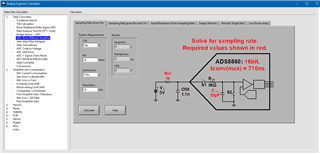Other Parts Discussed in Thread: TLA2518
Tool/software:
A while ago I had been searching e2e with initial design questions.
I dont know how i found it, but i ran into a spreadsheet twice where you put in the characteristics of the ADC (input resistance, sampling capacitance), and the characteristics of what is being sampled, and it tells you the effect that sampling has on the signal.
I've searched but could not find it, do you happen to know? (t was not for this particular adc)
thanks.


